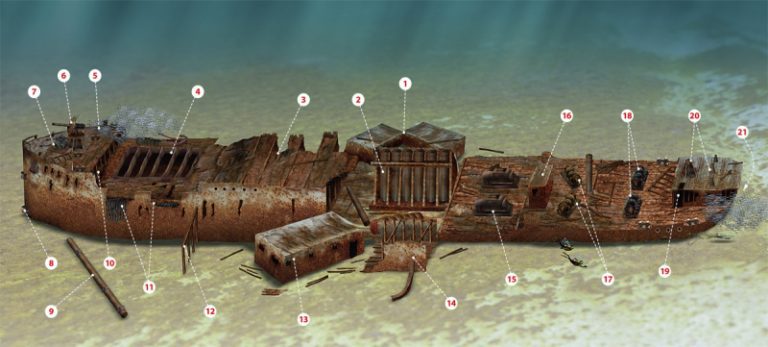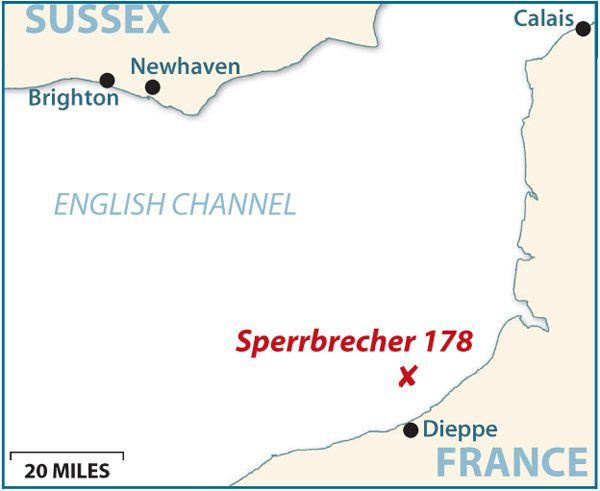It’s a while since we crossed the Channel for a Wreck Tour but this WW2 German pathfinder vessel off Dieppe is well worth the trip, says JOHN LIDDIARD. Illustration by MAX ELLIS
THIS MONTH’S TOUR takes us back to Dieppe for a more detailed look at another unusual class of warship that can be found at an easy depth of 20m.
Sperrbrecher means “Pathfinder” or “Pathmaker”. These ships were extensively adapted merchantmen designed to lead convoys and more valuable naval ships in coastal waters, particularly where there was a danger of mines.
They are often written about in connection with U-boats, leading the returning submarines through the minefields and back into harbour. Yet that was just one use for this class of ship.
Sperrbrechers were used as combined escorts, minesweepers and sacrificial lambs to lead coastal convoys.
Our tour of Sperrbrecher 178 begins to the starboard side of the wreck (1), where Rouen GCOB Plongée’s anchor-line was hooked across some large box-sections from the superstructure that have fallen this way.
French clubs like to hook the boat into the wreck and stop the engine, rather than have a live boat above divers. This does mean that you need to return up the anchor-line at the end of the dive.
In the middle of the wreck stands a six-cylinder diesel engine (2). Sperrbrecher 178 was a motor ship, so there are no boilers to find.
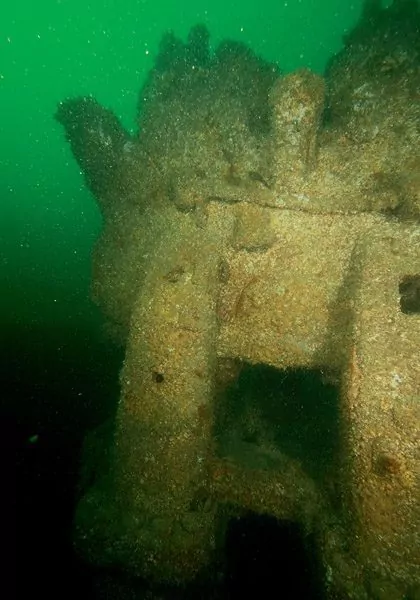
Turning forward, number two hold is covered over (3), though some openings are broken in the sides, particularly to starboard, and there are also some gaps in the bulkheads at either end, making entry possible, though this is not recommended for inexperienced divers.
The forward hold (4) is open, with an intact hatch-coaming. On the deck to the starboard side is a stockless anchor that may have been from the wreck, or may have been fouled later.
Inside the hold, against the aft bulkhead, is the noise-making machinery used to detonate acoustic mines.
Wrapped around the hull are thick electric cables used to detonate magnetic mines. In both cases, the idea was to create a signal so strong that mines would be detonated before they moved dangerously close to the ship.
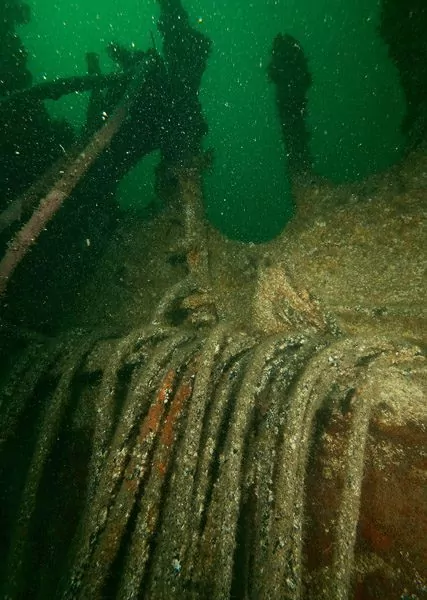
Both of these holds were once stuffed full of empty barrels and wood to provide supporting buoyancy in case of mines actually exploding against the hull.
The forecastle (5) steps up one deck level to 17m. In the centre of the deck is a naval 88mm gun (6). This was a lightweight gun designed for fitting to small ships, and not the notorious 88mm flak and anti-tank gun used by the German army.
Forward of the gun is an anchor-winch (7) with chains leading through hawse-pipes, and the port anchor still in place.
Over the bow, a set of clamps either side of the stem (8) would have held the post (9) from which minesweeping paravanes would have been towed, now resting a little off the port side at 22m.
Inside the forecastle, right by the door for easy access, crates of 88mm shells are stacked (10).
Heading aft again along the port side of the ship, breaks in the hull-plating reveal cables from the magnetic minesweeping system (11).
Approximately level with the second hold, an open frame (12) from the superstructure rests against the side of the hull, then a complete cabin (13) stands on the seabed.
Behind this, the side of the hull has fallen outward (14), with a boat derrick indicating which side was the deck.
Behind the main diesel engine, in the area that on the original Gauss would have been the third hold, are two diesel generators (15). These would have provided the considerable amount of electrical power required by the magnetic minesweeping system.
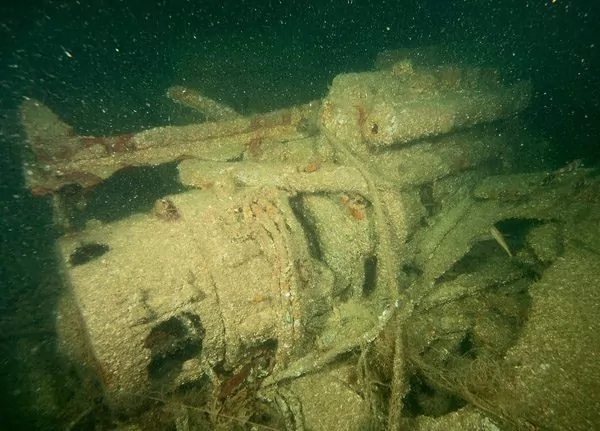
Next aft is a small deckhouse (16) and then a pair of angled winches (17) that would have been used to haul cables for sweeping contact mines.
With acoustic and magnetic mines already detonated, the remaining danger to a following convoy would be contact mines, and the system for sweeping these was to use these cables towed from either side of the ship, with paravanes to hold them well out to the side and thus sweep a wide path.
Between these winches is the stub of another mast, then a second pair of winches (18) which are not angled.
Possibly these were used to tow another set of minesweeping cables closer to the path of the convoy, or perhaps to tow barrage balloons above to discourage low-level air attacks.
At the stern, an intact deckhouse (19) provides a reinforced platform to mount pintles for anti-aircraft guns; first a single large pintle, then a trio of smaller ones (20). The guns themselves are no longer present.
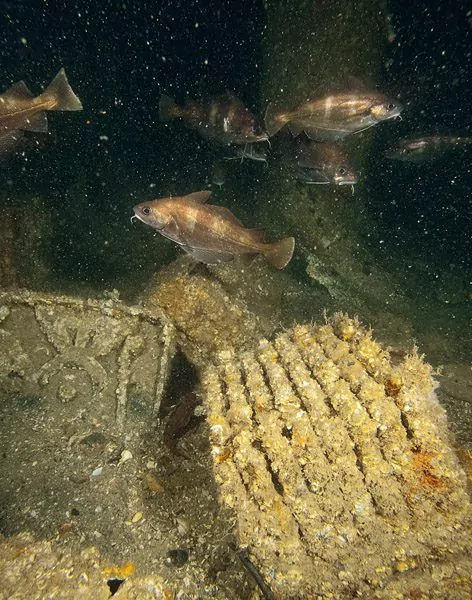
At the aft of the platform (21) and also in the cabin below are scattered clips and individual shells from the ammunition supply.
Even on air, a dive to this depth can easily cover the whole ship in about 40 minutes of no-stop time.
With nitrox and a twin-set, Sperrbrecher 178 is the sort of wreck most divers will continue to enjoy well into a long slack. Nevertheless, if diving the French system, remember to allow time to return to the anchor-line and ascend to your boat.
DESTROYED BY DESTROYERS
SPERRBRECHER 178/GAUSS, pathfinder. BUILT 1925, SUNK 1942
THIS VESSEL WAS ORIGINALLY LAUNCHED in 1925 by Deutsche Werke AG of Kiel as the 1236-ton motor ship Gauss for Neptun Dampfschiffahrt-Gesellschaft of Bremen.
In 1942 the Gauss was requisitioned and converted to Sperrbrecher 178, entering service in September of that year.
The ship was equipped with a noisemaker for detonating acoustic mines, electrical generators and 6000m of copper cable wound round the hull to detonate magnetic mines, paravanes to sweep contact mines, an 88mm bow gun, one 37mm and eight 20mm anti-aircraft guns.
On the night of 12 December, 1942, Sperrbrecher 178 and Sperrbrecher 144 (formerly the 1939 Dutch cargo ship Beijerland), with a number of smaller escorts, were leading a convoy from Boulogne along the French coast.
It was a clear, moonless night with a light sea, a slight wind from the south-west and average visibility. The convoy was proceeding at a speed of 7.5 knots.
At 10.40, to the north-east of Dieppe, it was intercepted by a flotilla of Allied destroyers. For two hours a fierce battle raged and a torpedo from HMS Whitshed struck Sperrbrecher 178 amidships, sinking the ship in 10 minutes. Only three survivors were recovered from the crew of 102.
The destroyers concentrated their attack on the larger warships. The Norwegian destroyer Eskdale torpedoed and sank Sperrbrecher 144, with no survivors. The smaller escorts and ships of the convoy escaped to the safety of Dieppe, though some had sustained considerable damage in battle.
Out of more than 100 sturdy merchant ships converted to this dangerous role, nearly 50% were lost in action. After the war, some of the surviving ships were converted back to merchant service.
TOUR GUIDE
GETTING THERE: LD Lines Transmanche Ferries has twice-daily crossings from Newhaven to Dieppe. Five-day return fares for car and two passengers start from £44, 0844 576 8836.
HOW TO FIND IT: The GPS co-ordinates are 50 03.331N, 001 06.705E (degrees, minutes and decimals). The wreck lies with its bow pointing to the south-east.
TIDES: On neap tides, slack water begins approximately one hour before and five hours after high water Dover. Bear in mind that French clocks are one hour ahead of the UK.
DIVING & AIR: John Liddiard was a guest of French club GCOB Plongée. Alternatively, UK boats operating from Eastbourne, Brighton and Littlehampton have conducted multi-day cross-channel trips, either taking divers with them or meeting divers in Dieppe.
ACCOMMODATION: Office de Tourisme Dieppe Maritime.
LAUNCHING: Slips are available in Dieppe, but first make sure that your boat and boat-handlers are fully licensed with the French authorities.
QUALIFICATIONS: At low-water slack, the seabed is just beyond the depth limit for PADI Open Water or BSAC Ocean Divers.At low-water slack, the seabed is just beyond the depth limit for PADI Open Water or BSAC Ocean Divers.
FURTHER INFORMATION: Admiralty Charts 2451, Newhaven To Dover and 2147, Approaches To Dieppe.
PROS: Another unique warship in excellent condition.
CONS: French diving regulations are much stricter than those at home.
DEPTH: 20m – 35m
Thanks to Alan Waite, Jean-Luc Lemaire, Denis, Dominique, Raymond and many members of Rouen GCOB Plongée.
Appeared in DIVER November 2012
